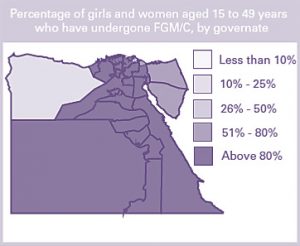Related Articles
Women’s leadership, COVID-19 & female genital cutting
22 September 2020
Africa
02 March 2019

99.8 million
87%
1.87%
70%
The most widely practised forms of female genital cutting (FGC) in Egypt are Type I and Type II.
Almost all girls and women in Egypt (96%) undergo FGC before the age of 12. The majority of girls (64%) undergo FGC between the ages of nine and 12.
Source: UNFPA-UNICEF
The main practitioners are health providers. Since at least 2008, there has been an increase in the medicalisation of FGC in Egypt. The 2015 Health Issues Survey shows 79% of girls from 0-17 underwent procedures carried out by health professionals.
Source: UNFPA-UNICEF
Illegal. Legislation criminalising FGC has been in place since 2008. Enforcement is inadequate, however, with convictions rare and sentences lenient.
Source: UNFPA-UNICEF
1994 – Egypt adopted a regulation approach through medicalising the practice in a 1994 Ministry of Health Decree, which rolled back a 35-year ban on practising FGC in state hospitals. The policy was reversed the same year, but allowed a loopphole for “medically necessary circumcision” which continued until 2007
1996 – FGC in Egypt first made illegal
2008 – New FGC legislation introduced via amendments to the Child Act (1996) and Penal Code, although medical practitioners continue to perform FGC
2016 – Amendment of anti-FGC law to include stricter penalties, making FGC a crime rather than a misdemeanour
During Phase II of the UNFPA-UNICEF joint programme (2014-2017), 31,138 families and 30 communities made public declarations of FGC abandonment.
Source: UNFPA-UNICEF
115 in 2018 index, based on 2017 data.
20 deaths per 1,000 live births (2015).
Source: 28 Too Many
33 deaths per 100,000 live births (2015).
Source: 28 Too Many
Prevalence rates have decreased in recent years (from 91% in 2008 to 87% in 2015, according to EHIS 2015). Since the 2011 revolution, however, the perception of efforts to end FGC being attached to the overthrown Mubarak regime meant that challenges and obstacles to the work to end FGC in Egypt have increased. The 25th January 2011 Egyptian revolution led to uncertainty and freezing of FGC programmes. The Muslim Brotherhood period from 30th June 2012 – 3rd July 2013 also resulted in regression on programming on the practice, and since the Al Sisi regime began in July 2013, there has been no evidence of a systemic movement against cutting. In addition, around half of people in Egypt still support the continuation of FGC and believe it is a religious requirement.
Source: UNFPA-UNICEF
By region
FGC in Egypt is widely practised. Prevalence rates above 80% are seen across large parts of the country, with only a relatively small area in the north-west displaying a rate below 25%.

Source: UNICEF and UNFPA-UNICEF
Stay up-to-date with stories of change, news and research about ending female genital cutting by signing up to our newsletter.
If you have any questions, please get in touch.
4.3 million girls around the world are currently at risk of being cut every year.
Your donation will help us accelerate an end to female genital mutilation/cutting (FGM/C) around the world.
